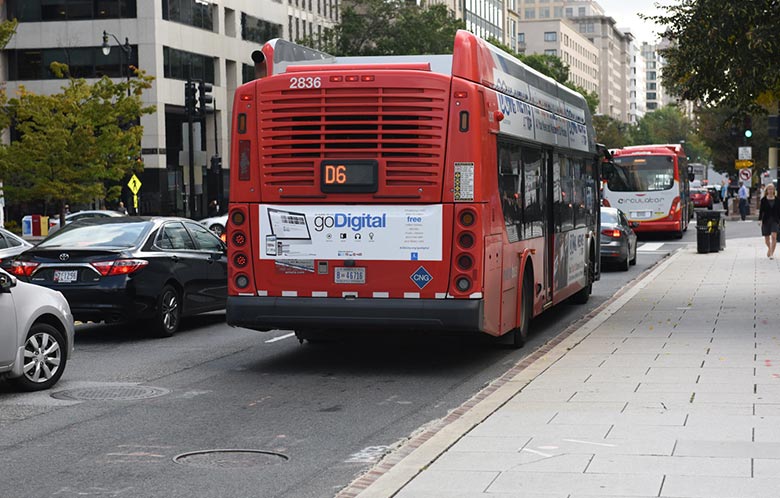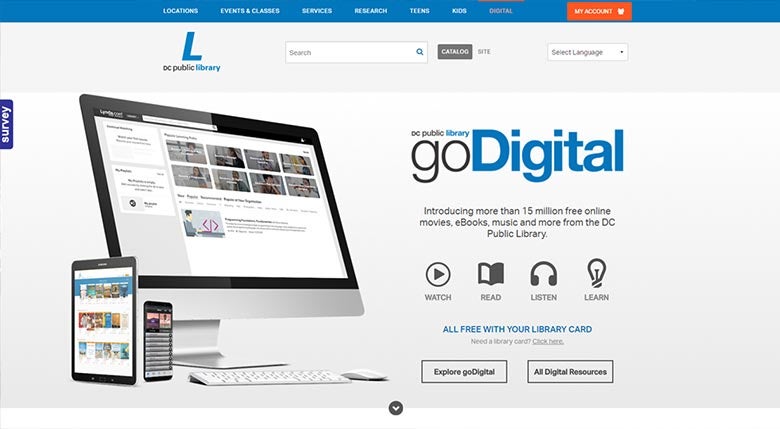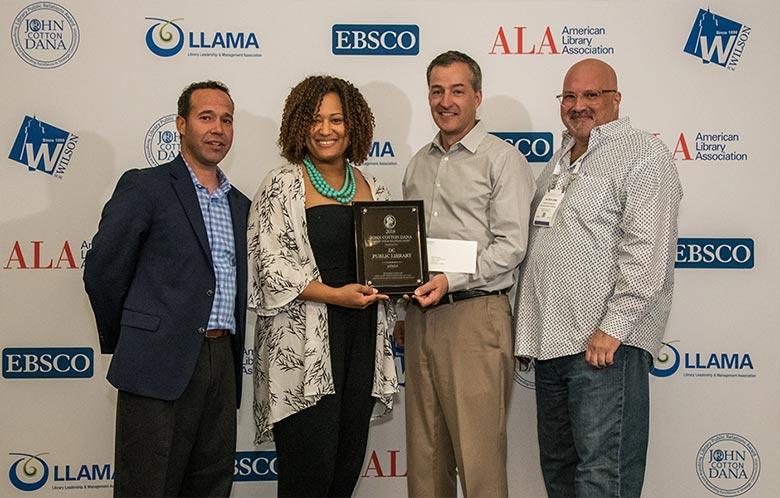Briefly describe your winning campaign. What was the goal?
The DC Public Library's goDigital Working Group, a knowledgeable cross-functional section of library staff and web development consultants, launched goDigital. It's an easy-to-use web portal that exists inside the library's main website, which allows users to find everything related to the library’s online digital collection in one, user-friendly location.
The working group was charged with increasing the awareness and usage of the library’s digital collection through a citywide awareness campaign. The working group adopted a simple, but catchy campaign name, goDigital, which left little need for an elaborate explanation of what the customer could expect. The primary target audience had not taken advantage of the wealth of online resources available at the library and were identified as District residents, ages 18-64 that live in wards 7 and 8 (east of the river). Additionally, the working group conducted primary research. The data from surveys and focus groups informed how the project was developed.
The campaign theme (Watch. Read. Listen. Learn.) divides the campaign into four action verbs that resonate with customers. Customers are unaware of library jargon, but they know what they want to do when at the library. Therefore, the more than one hundred online resources were curated by the action verbs Watch, Read, Listen and Learn to help users quickly find what they want.

How has implementing public relations at your library improved its community involvement?
Implementing public relations helps to keep our community invested in what we do. DC Public Library was especially mindful to keep the community engaged with the development of goDigital.
During our primary research, we collected data to better understand customer and staff knowledge about the digital resources offered at the DC Public Library. Three different types of surveys were administered – Voice of Patron, in-branch and staff.
Voice of Patron (VoP)
Voice of Patron collects both survey and behavioral data. Typically Voice of Patron is used as a research component before website architecture is built; however, this time it was used to help shape the digital campaign. The survey was customized to digital users instead of overall website usage. Data analysis included crowdsourcing/weighing responses to make sense of qualitative data.
The Voice of Patron survey had ten questions and was administered through the Library’s website. A pop-up screen displayed on random user screens asking if they would like to participate in a survey. In addition to the Library’s website, the survey code was hosted on OverDrive, Freegal, Zinio, LibGuides and the Library catalog. The survey was available for about eight weeks. We collected 1,303 responses.
In-Branch
Eight library locations in the primary target audience areas were identified to host an in-branch survey. Six library volunteers administered a 10-question survey via iPads over a four-week period. We collected 100 surveys.
Staff
DC Public Library staff were given the opportunity to share their ideas about the digital campaign. An electronic survey, available through Google Forms, was released to staff for a period of four weeks. The 10-question survey collected data about staff’s knowledge of digital offerings, their comfort level with promoting digital resources and their suggestions for website improvements. Nearly one-third (185) of the staff responded to the survey. As encouragement to complete the survey, staff were offered a chance to win a goDigital Essentials Kit chock full of fun items like a smartphone armband, tablet stand, dual earbuds and USB car charger hub.
Focus Groups
A series of internal and external focus groups were held to find out what staff and public users thought about a prototype of the Library’s goDigital website and supporting print collateral. Their feedback was used to make final adjustments to the website and print materials before launching the awareness campaign. Participants were given a goDigital Essentials Kit chock full of fun items like a smartphone armband, tablet stand, dual earbuds and USB car charger hub and refreshments.
In summary, employing public relations helps:
- To deliver products and services that the community wants
- To make the community feel vested in what the library does
- To inspire the community to promote library services and products
Implementing public relations helps to keep our community invested in what we do. DC Public Library was especially mindful to keep the community engaged with the development of goDigital.
Implementing public relations helps to keep our community invested in what we do. DC Public Library was especially mindful to keep the community engaged with the development of goDigital.
What Were the Lessons Learned?
There were several lessons learned that will be incorporated into future projects. First, it was invaluable to have staff and the public involved during the planning. The insights learned from each group played a significant role in how the final product and awareness campaign was developed. Second, meeting with various stakeholders to keep them informed about the project and the progress was extremely helpful. In fact, having an open and frequent line of communication made it easier to execute the project. Third, frequent monitoring of the project was tremendously helpful. The team was able to adjust tactics to help reach our website visits goal. Tactics included creating anchor links and placing paid social media ads with a call-to-action.
In the end:
- goDigital website visits were 14 percent above the goal
- Digital library usage with residents east of the river increased by 24 percent, 14 percent above the goal
- Overall, digital library circulation increased by 36 percent, 26 percent above the goal.

What are some tips that you would give to other librarians that would like to learn more about marketing their library?
I would recommend creating an educational plan that fits in with your work/life schedule. Commit to learning something new once a month. Various options include reading articles, joining a professional organization and participating in chapter events or taking a class. Some of these options like Lynda.com and Universal Class might already be available through your library.
Chat Groups
Online Learning
Professional Organizations

What piece of advice would you give libraries that were considering applying for the John Cotton Dana awards?
The following best practices should provide you with everything you need to submit a winning John Cotton Dana Award entry.
- Do your best work: This should go without saying. Whether you apply for an award or not, always put your best work forward. Ultimately, you are responsible for the success or failure, and the work is a direct reflection of you.
- Let research get you started: Don’t just follow your hunch or a co-worker’s opinion. Make the time to conduct primary research or pull historical data that will help inform your project.
- Have a Solid Plan: Have an understanding of why you are working on a project. Identify the problem and develop measurable goals.
- Collaboration is key: Have you ever heard the saying “two heads are better than one?” Collaborating with partners or co-workers helps you stay focused, allows you to delegate tasks, provides a sounding board for ideas, and expands the knowledge and experience available for the project.
- Engage Stakeholders: It’s important that you know who your stakeholders are. It will be to your advantage to proactively keep them informed about the project. Receiving buy-in from your stakeholders will ensure that you have a successful project. And remember, stakeholders can include anyone that has an interest in your library including, the public, library board, elected officials and executive staff.
- Monitor Performance: To ensure that your project stays on track, you have to constantly monitor performance. Monitoring will tell you if the project is performing as expected. If the project is underperforming, you have an opportunity to make adjustments that will hopefully have a positive impact on performance.
